20 Powerful Problem-Solving Techniques for the Modern Workplace: A Comprehensive Guide
Here’s a fact…
Organizations that are great at solving problems are about 3.5 times more likely to grow their income faster than other companies!
But what’s so crucial about problem-solving that makes such a big impact?
What is Problem-Solving?
Problem-solving is about finding and fixing issues that stop a company from reaching its goals.
Being good at solving problems is important for businesses to do well and for people to move up in their careers.
Pursuing a Six Sigma certification can provide you with structured methodologies and tools to excel in problem-solving, boosting both personal career growth and organizational success.
Companies that are great at solving problems can:
- Get more work done with less waste
- Make customers happier
- Come up with new ideas
- Change quickly when the market changes
For people, getting better at solving problems can help them:
- Move up faster in their job
- Enjoy their work more
- Make better choices
- Become better leaders
Turn Problems Into Opportunities with Six Sigma Training!
Master the art of problem-solving through our hands-on Six Sigma training programs. Learn to identify root causes, eliminate inefficiencies, and drive measurable improvements using proven tools and techniques.
The Evolution of Problem-solving Techniques
Traditional problem-solving approaches often relied on linear thinking and standardized processes. While these methods still have their place, contemporary problem-solving techniques have evolved to meet the demands of our complex, interconnected business world.
Modern problem-solving techniques emphasize:
- Systems thinking
- Cross-functional collaboration
- Data-driven decision-making
- Rapid prototyping and iteration
Adapting to fast-paced, digital environments requires a blend of traditional wisdom and innovative approaches. For instance, while the core principles of Six Sigma remain relevant, we now apply them in conjunction with agile methodologies and digital tools to solve problems more efficiently.
Key Skills for Effective Problem-solving
To excel in problem-solving, professionals need to develop a diverse skill set:
- Analytical thinking: The ability to break down complex issues into manageable components and identify root causes.
- Creativity: Generating innovative solutions and thinking outside the box.
- Communication: Clearly articulating problems and solutions to stakeholders at all levels.
- Adaptability: Remaining flexible and open to new approaches as situations evolve.
By honing these skills and applying the right problem-solving techniques, you can tackle even the most challenging business issues with confidence.
Ready to enhance your problem-solving skills?
Get started with our Lean Six Sigma Green Belt training, which covers essential techniques like Root Cause Analysis and Process Mapping. Enroll now to boost your analytical and creative problem-solving abilities.
The Fundamental Problem-Solving Process
Whether you’re troubleshooting a manufacturing issue or optimizing a business process, the fundamental problem-solving procedure remains the same.
Let me walk you through the key problem-solving steps that I’ve successfully implemented across various industries.
Identifying and Defining the Problem
The first and most crucial step in any problem-solving technique is accurately identifying and defining the problem. In my experience, many organizations rush to solutions without fully understanding the root cause of their issues. To avoid this pitfall, I recommend using these root-cause analysis techniques:
- The 5 Whys: This simple yet powerful method involves asking “Why?” five times to dig deeper into the problem’s origin.
- Fishbone Diagram: Also known as the Ishikawa diagram, this visual tool helps identify potential causes of a problem across different categories.
Once you’ve identified the root cause, it’s essential to frame a clear problem statement. This statement should be specific, measurable, and actionable.
For example, instead of saying “Customer satisfaction is low”, a better problem statement would be “Customer satisfaction scores have decreased by 15% in the past quarter, primarily due to longer response times in our customer service department”.
Gathering and Analyzing Relevant Information
After defining the problem, the next step in the problem-solving procedure is to collect and analyze relevant data. In my work with companies like GE and HP, I’ve found that data-driven decision-making is crucial for effective problem-solving. Here are some data collection methods and analytical tools I frequently use:
- Surveys and interviews
- Process mapping
- Statistical analysis (e.g., regression analysis, hypothesis testing)
- Pareto charts to identify the most significant factors
Generating Potential Solutions
With a clear understanding of the problem and relevant data in hand, it’s time to generate potential solutions. This is where creative problem-solving techniques come into play. I often employ a mix of individual and group ideation techniques, such as:
- Brainstorming sessions
- Mind mapping
- SCAMPER technique (Substitute, Combine, Adapt, Modify, Put to another use, Eliminate, Reverse)
- Nominal Group Technique for team-based idea generation
Evaluating and Selecting the Best Solution
Once you have a list of potential solutions, it’s crucial to evaluate them systematically. In my workshops, I teach various decision-making frameworks, including:
- Decision matrices
- Cost-benefit analysis
- SWOT analysis (Strengths, Weaknesses, Opportunities, Threats)
It’s also essential to conduct a thorough risk assessment of each potential solution. This helps in identifying and mitigating any potential negative consequences before implementation.
Implementing and Monitoring the Solution
The final step in the problem-solving process is implementation and monitoring. This involves:
- Developing a detailed action plan with clear responsibilities and timelines
- Implementing the solution on a small scale (pilot test) when possible
- Establishing key performance indicators (KPIs) to measure the solution’s effectiveness
- Regularly monitoring and adjusting the solution as needed
These steps mirror Six Sigma’s DMAIC process, which you can master through Six Sigma certification programs designed to tackle workplace challenges efficiently.
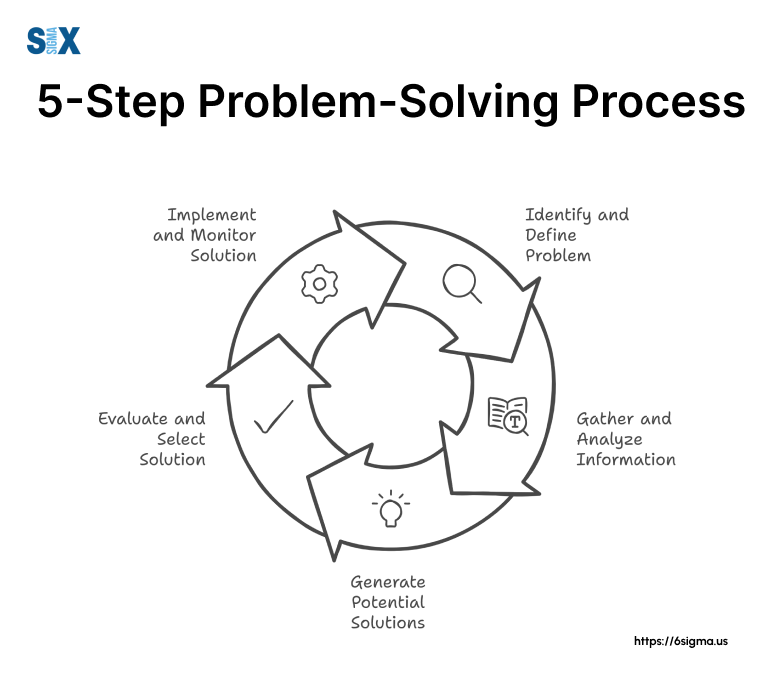
Individual Problem-Solving Techniques
From optimizing manufacturing processes to streamlining business operations, I’ve learned that having a diverse toolkit of problem-solving techniques is crucial for success.
In this section, I’ll share some of the most effective individual problem-solving techniques I’ve used and taught in my workshops worldwide.
Analytical Techniques
- SWOT Analysis
SWOT Analysis is a versatile problem-solving technique that I frequently use when helping organizations identify strategic opportunities. It involves analyzing Strengths, Weaknesses, Opportunities, and Threats.
For example, when I worked with a major tech company to improve their product development process, we used SWOT to identify internal capabilities and external market factors that could impact their innovation strategy. - Pareto Analysis
Also known as the 80/20 rule, Pareto Analysis is a powerful tool for prioritizing problems. I’ve found it particularly useful in manufacturing environments.
During a project with a leading automotive supplier, we used Pareto Analysis to identify that 80% of their quality issues stemmed from just 20% of their processes, allowing us to focus our improvement efforts effectively. - 5 Whys
The 5 Whys is a simple yet profound technique for root cause analysis. By asking “why” five times, you can dig deeper into the underlying causes of a problem.
I once used this method with a healthcare provider to uncover the root cause of patient wait times, which led to a 30% reduction in delays.
Techniques like the 5 Whys and Pareto Analysis are core to Six Sigma certification—a Six Sigma Green Belt Certification can teach you how to apply them effectively.
Creative Techniques
- Mind Mapping
Mind Mapping is one of my favorite creative problem-solving techniques. It’s a visual tool that helps organize thoughts and ideas around a central concept.
When working with a software company to improve its customer support process, we used mind mapping to brainstorm and categorize potential solutions, leading to a more holistic approach to customer satisfaction. - Reverse Brainstorming
This technique involves reversing the problem statement to generate new perspectives. Instead of asking “How can we improve product quality?”, we ask “How can we make the product worse?”
This often leads to surprising insights. I’ve successfully used this method in workshops to help teams break out of conventional thinking patterns. - SCAMPER Method
SCAMPER (Substitute, Combine, Adapt, Modify, Put to another use, Eliminate, Reverse) is a versatile creative problem-solving technique. When consulting for a consumer goods company, we used SCAMPER to redesign a product line, resulting in innovative features that boosted sales by 15%.
Decision-Making Techniques
- Decision Matrix
A Decision Matrix helps evaluate and prioritize options based on weighted criteria. I’ve found this particularly useful when working with executive teams to make complex strategic decisions.
For instance, when helping a telecommunications company choose between expansion strategies, we used a decision matrix to objectively assess each option against key business objectives. - Pros and Cons Analysis
While simple, a thorough Pros and Cons Analysis can be incredibly effective. I often use this technique as a starting point in my problem-solving workshops to help teams quickly assess potential solutions before diving deeper. - Cost-Benefit Analysis
In my experience, a rigorous Cost-Benefit Analysis is crucial for justifying improvement initiatives to stakeholders.
When working with a government agency to streamline its operations, we used this technique to demonstrate the long-term financial benefits of process improvements, securing buy-in for a major transformation project.
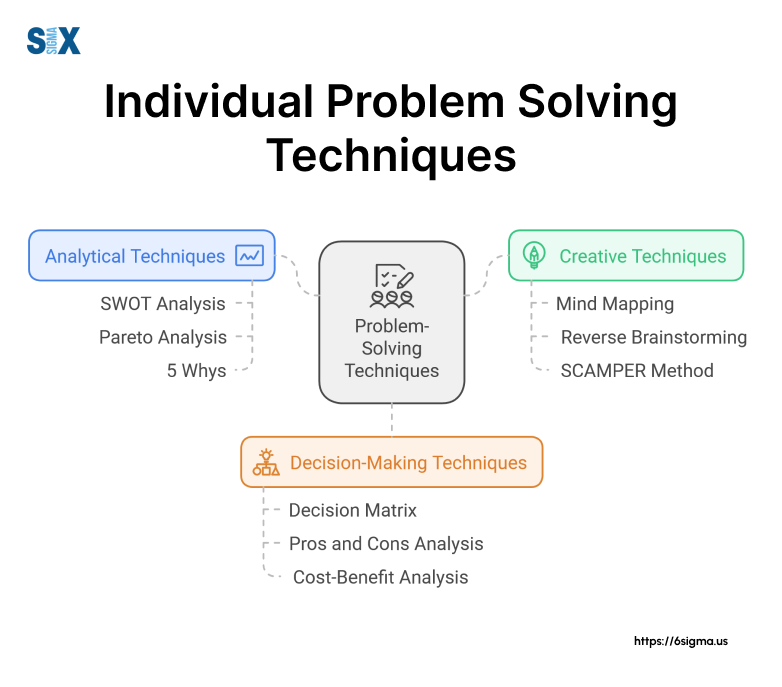
Case Study: Revolutionizing Inventory Management
A few years ago, I worked with a large electronics manufacturer facing significant inventory management challenges. Here’s how we applied multiple techniques to solve their problem:
- We started with a SWOT Analysis to understand their current inventory management system’s strengths and weaknesses.
- Using Pareto Analysis, we identified that 80% of their excess inventory issues were related to just 20% of their product lines.
- We applied the 5 Whys technique to dig into the root causes of overstocking in these key product lines.
- To generate innovative solutions, we used Mind Mapping and the SCAMPER method in brainstorming sessions with cross-functional teams.
- Finally, we employed a Decision Matrix to evaluate and select the most promising solutions, followed by a detailed Cost-Benefit Analysis to justify the implementation.
The result? The company reduced excess inventory by 40% within six months, leading to significant cost savings and improved cash flow.
Team-Based Problem-Solving Techniques
I’ve seen firsthand how team-based problem-solving techniques can unlock innovative solutions and drive transformative change.
Collaborative Techniques
- Brainstorming
Brainstorming remains one of the most popular problem-solving techniques in the workplace. The key to effective brainstorming is creating an environment where all ideas are welcomed and judgment is suspended.
For example, during a project with a major automotive manufacturer, a brainstorming session led to a novel approach to supply chain optimization, resulting in a 15% reduction in lead times. - Nominal Group Technique
The Nominal Group Technique is a structured brainstorming method that I often use when working with diverse teams. This technique involves individual idea generation followed by group discussion and voting.
I found this particularly effective when helping a healthcare provider redesign their patient intake process. By giving equal voice to frontline staff and administrators, we developed a solution that improved patient satisfaction scores by 30%. - Delphi Method
For complex problems requiring expert input, the Delphi Method is one of my go-to problem-solving strategies. This technique involves multiple rounds of anonymous questionnaires and feedback. I’ve successfully employed this method in long-term strategic planning for various organizations.
In one instance, we used the Delphi Method to help a technology company forecast future market trends, leading to a successful product diversification strategy.
Structured Problem-Solving Approaches
- Six Thinking Hats
Edward de Bono’s Six Thinking Hats is a powerful technique for looking at problems from multiple perspectives. I’ve integrated this method into many of my Six Sigma workshops.
When working with a financial services firm to improve their risk assessment process, we used the Six Thinking Hats approach to ensure we considered emotional, creative, and critical viewpoints, resulting in a more robust risk management framework. - Design Thinking
Design Thinking is an iterative problem-solving process that I’ve found particularly useful for customer-centric challenges. During a project with a major e-commerce platform, we employed Design Thinking to reimagine their user experience.
By empathizing with users, defining pain points, ideating solutions, prototyping, and testing, we developed an interface that increased user engagement by 25%. - Lean Problem-Solving
Rooted in the Toyota Production System, Lean Problem-Solving focuses on eliminating waste and improving efficiency. I’ve applied this methodology extensively in manufacturing environments.
For instance, when working with a consumer electronics manufacturer, we used Lean Problem-Solving techniques to streamline their production line, resulting in a 20% increase in throughput and significant cost savings.
Conflict Resolution Techniques
- Win-Win Approach
The Win-Win Approach is crucial for resolving conflicts in team problem-solving scenarios. I always emphasize this technique in my leadership workshops.
During a merger between two competing departments at a large corporation, we used the Win-Win Approach to find solutions that benefited both parties, leading to a smoother integration and improved overall performance. - Compromise and Negotiation
Effective compromise and negotiation skills are essential in team-based problem-solving. I’ve coached numerous executives on these techniques.
In one instance, when mediating a dispute between a company and its suppliers, our negotiation approach led to a mutually beneficial agreement that strengthened the supply chain and reduced costs for both parties. - Mediation
As a neutral third party, mediation can be a powerful tool for resolving team conflicts. I’ve often played the role of mediator in complex organizational disputes.
For example, when resolving a conflict between marketing and product development teams at a software company, our mediation process not only solved the immediate issue but also established better communication channels for future collaboration.
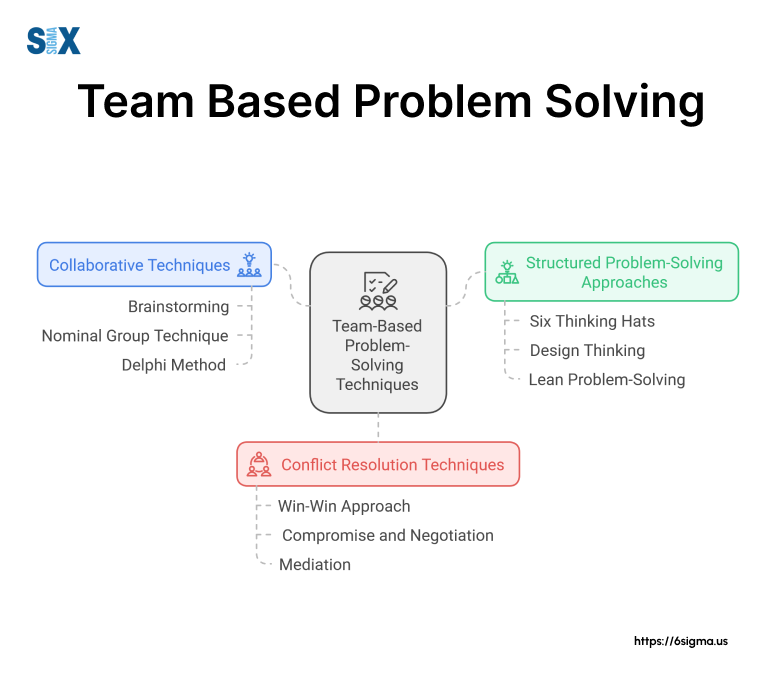
Master advanced problem-solving methods!
Our Lean Six Sigma Black Belt program delves deep into statistical tools and leadership techniques.
Industry-Specific Problem-Solving Applications
What I’ve learned is that while the core principles of problem-solving remain consistent, their application can vary significantly depending on the industry context.
Let’s talk about some industry-specific problem-solving techniques that I’ve found particularly effective in my consulting work.
Manufacturing and Operations
- Six Sigma
Six Sigma is a data-driven problem-solving technique that I’ve implemented extensively in manufacturing environments. During my consulting time, we used Six Sigma to reduce defects in a production line by 99.99%, resulting in millions of dollars in savings.
The DMAIC (Define, Measure, Analyze, Improve, Control) framework of Six Sigma provides a structured approach to identifying and solving complex manufacturing problems. - Kaizen
Kaizen, or continuous improvement, is another powerful problem-solving technique in manufacturing. I’ve facilitated numerous Kaizen events, including one at a major automotive parts supplier where we reduced setup times by 50%.
The key to Kaizen’s success is its focus on small, incremental improvements that add up to significant gains over time.
To deepen your expertise in applying Six Sigma to manufacturing, a Six Sigma Black Belt certification offers advanced training in reducing defects and improving processes.
Technology and Software Development
- Agile Methodologies
In the fast-paced world of tech, Agile methodologies have revolutionized problem-solving. When working with a leading software company, we implemented Scrum, an Agile framework, to improve their product development process.
This resulted in a 30% reduction in time-to-market for new features and increased customer satisfaction. - A/B Testing
A/B testing is a problem-solving technique I often recommend for digital products. In a project with an e-commerce platform, we used A/B testing to optimize their checkout process, leading to a 15% increase in conversion rates.
This method allows for data-driven decision-making in real-time, which is crucial in the rapidly evolving tech landscape.
Healthcare
- Root Cause Analysis (RCA)
In healthcare, patient safety is paramount, making Root Cause Analysis a critical problem-solving technique. I once worked with a large hospital to implement RCA in their medication error reporting system.
This led to a 40% reduction in medication errors over six months by identifying and addressing systemic issues. - Plan-Do-Study-Act (PDSA) Cycle
The PDSA cycle is another effective problem-solving technique in healthcare. When helping a clinic improve its patient wait times, we used PDSA to test and refine various interventions.
This iterative approach allowed us to reduce average wait times by 25% while ensuring that the changes didn’t negatively impact patient care quality.
Finance and Business Strategy
- Scenario Planning
In the volatile world of finance, scenario planning is a crucial problem-solving technique. I’ve used this method with several financial institutions to prepare for potential market disruptions.
For instance, we helped a regional bank develop robust contingency plans for various economic scenarios, which proved invaluable during the 2008 financial crisis. - Porter’s Five Forces
Porter’s Five Forces is a strategic problem-solving framework I often employ when working on business strategy issues.
In a project with a retail chain facing increasing competition, we used this model to analyze the competitive landscape and identify new market opportunities, leading to a successful expansion strategy.
Case Study: Revolutionizing Manufacturing with Industry 4.0
I worked with a large manufacturing company that was struggling with efficiency and quality issues. Here’s how we applied multiple techniques to solve their problems:
- We started with a Six Sigma DMAIC project to identify the root causes of quality issues.
- Implemented Kaizen events to drive continuous improvement on the shop floor.
- Utilized Agile methodologies to develop a custom IoT solution for real-time monitoring of production lines.
- Employed A/B testing to optimize the user interface of the monitoring system for maximum operator efficiency.
The result? A 40% reduction in defect rates, a 25% improvement in overall equipment effectiveness, and a successful transition into Industry 4.0 practices.
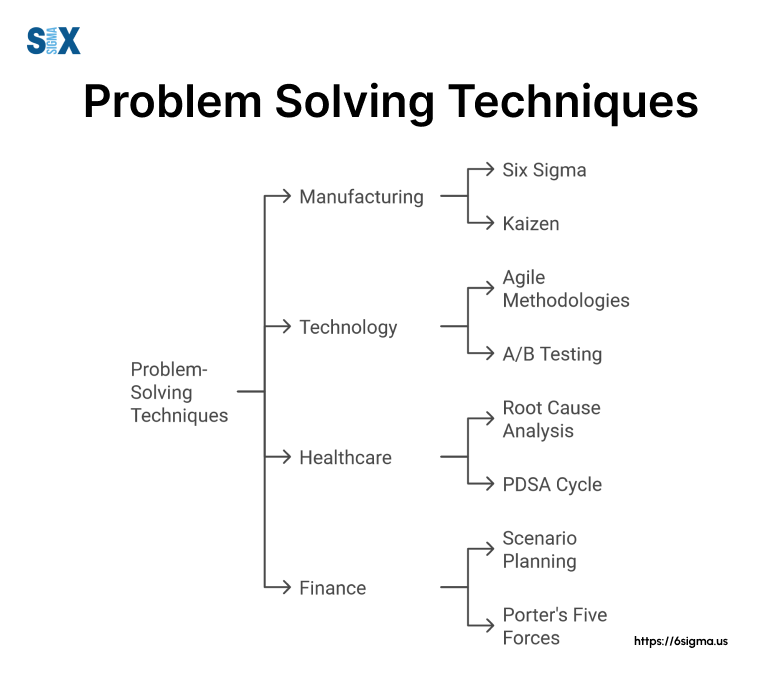
By understanding and applying these industry-specific problem-solving techniques, you can tackle the unique challenges in your field more effectively. Remember, the key is to adapt these methods to your specific context and combine them when necessary for optimal results.
Problem-solving in Remote and Digital Environments
I’ve witnessed firsthand the dramatic shift toward remote and digital work environments. This transition has brought new challenges to the problem-solving landscape and opened up exciting opportunities for innovation.
Challenges of Virtual Problem-Solving
- Communication Barriers
One of the biggest hurdles I’ve encountered in remote problem-solving is the lack of face-to-face interaction.
Non-verbal cues, crucial in understanding team dynamics, are often lost in virtual settings. During a project with a global team, we had to work extra hard to ensure clear communication across different time zones and cultures. - Collaboration Limitations
Virtual environments can sometimes hinder spontaneous collaboration. The casual “water cooler” conversations that often spark innovative ideas are less frequent. In a project, we had to deliberately create virtual spaces for informal interactions to maintain team creativity and cohesion.
Digital Tools for Remote Problem-Solving
- Virtual Whiteboards
I’ve found virtual whiteboards to be indispensable for remote problem-solving. Tools like Miro or MURAL allow teams to visualize problems and solutions collaboratively.
In a Six Sigma workshop I conducted for a government institution, we used a virtual whiteboard to create a detailed fishbone diagram, which helped identify the root causes of a complex process issue. - Online Collaboration Platforms
Platforms like Microsoft Teams or Slack have become central to remote problem-solving efforts. We used these tools to create dedicated channels for different aspects of our problem-solving process, from data analysis to solution brainstorming.
Techniques for Effective Virtual Brainstorming
- Silent Brainstorming
Silent brainstorming has become one of my favorite techniques for virtual environments. It involves having team members independently write down ideas before sharing them.
This method helps overcome the challenge of dominant voices in virtual meetings and ensures all ideas are heard. I recently used this technique which resulted in a 30% increase in the number of ideas generated compared to traditional verbal brainstorming. - Round-Robin Ideation
Round-robin ideation is another effective virtual problem-solving technique. Each team member takes turns presenting an idea, ensuring equal participation.
In a project we used this method to tackle a complex supply chain issue, resulting in a diverse range of solutions that we might not have uncovered in a less structured format.
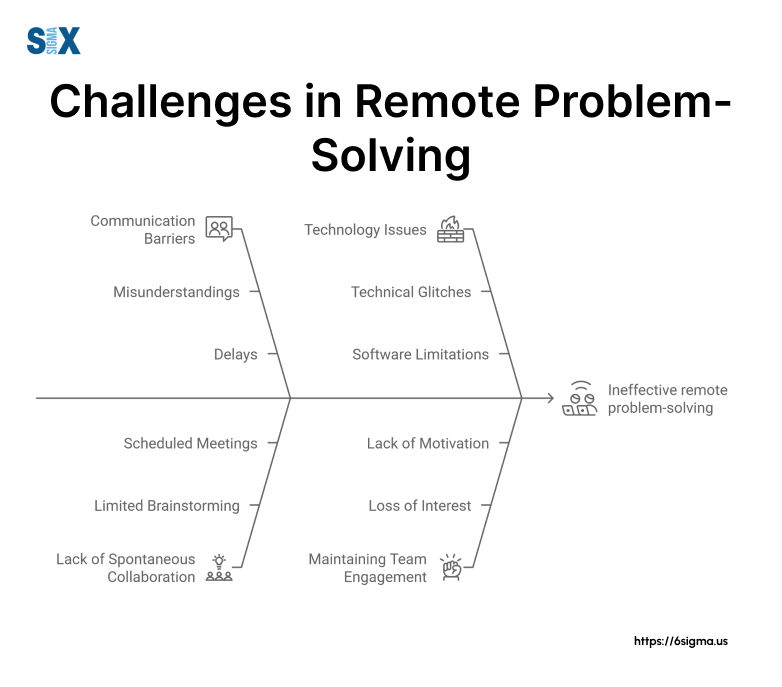
Tips for Effective Remote Problem-Solving
- Establish clear communication protocols
- Use visual aids and collaborative tools
- Schedule regular check-ins and informal virtual meetings
- Encourage active participation from all team members
- Be mindful of time zones and cultural differences
- Utilize asynchronous communication when appropriate
- Invest in reliable technology and provide the necessary training
By adapting our problem-solving techniques to remote and digital environments, we can overcome the challenges and harness the unique advantages of virtual collaboration. In my experience, remote problem-solving can lead to more diverse perspectives and innovative solutions when done right.
Looking to implement effective problem-solving strategies across your entire organization?
Looking to implement effective problem-solving strategies across your entire organization? Our Lean Six Sigma Champion Leadership program equips executives with the skills to drive continuous improvement and foster a problem-solving culture.
Emerging Trends and Technologies in Problem-Solving
The emergence of new technologies has revolutionized how we approach challenges, offering unprecedented opportunities for efficiency and innovation.
Data-Driven Problem-Solving
- Big Data Analytics
The explosion of big data has transformed problem-solving techniques in the business. During a recent project with a major retailer, we leveraged big data analytics to optimize their supply chain.
By analyzing vast amounts of historical sales data, weather patterns, and social media trends, we developed a predictive model that reduced stock-outs by 35% while minimizing excess inventory. - Predictive Modeling
Predictive modeling has become one of the best problem-solving techniques in my toolkit. In a project with a telecommunications company, we used predictive modeling to anticipate network outages before they occurred.
This proactive approach allowed the company to reduce downtime by 50%, significantly improving customer satisfaction.
AI and Machine Learning in Problem-Solving
- Pattern Recognition
AI-powered pattern recognition has dramatically enhanced our ability to identify complex problems. In a recent manufacturing project, we implemented an AI system that could detect subtle anomalies in product quality that human inspectors often miss. This led to a 40% reduction in defect rates and substantial cost savings. - Automated Decision-Making
Automated decision-making systems are revolutionizing how we solve routine problems. For instance, in a project with a financial services firm, we developed an AI-driven system for credit approval. This not only sped up the process but also improved the accuracy of credit decisions by 25%.
Augmented and Virtual Reality Applications
- Simulations for Complex Problem-Solving
Augmented Reality (AR) and Virtual Reality (VR) have opened up new frontiers in problem-solving, especially for complex systems. In a recent aerospace project, we used VR simulations to troubleshoot engine design issues.
This allowed engineers to visualize and interact with 3D models, leading to faster problem identification and more innovative solutions. - Virtual Collaboration Environments
VR is also transforming how teams collaborate on problem-solving. In a global project for a tech giant, we used a virtual collaboration environment to bring together experts from different continents.
This immersive experience facilitated better communication and idea sharing, resulting in more creative solutions to complex technical challenges.
Emerging Technologies in Problem-Solving
- Big Data Analytics
- Predictive Modeling
- AI-Powered Pattern Recognition
- Automated Decision-Making Systems
- Augmented Reality Simulations
- Virtual Reality Collaboration Environments
- Quantum Computing for Complex Calculations
- Internet of Things (IoT) for Real-Time Data Collection
- Blockchain for Transparent Problem Tracking
- Natural Language Processing for Sentiment Analysis
These emerging technologies are not just tools; they’re reshaping the very nature of problem-solving in business. As a Six Sigma practitioner, I’ve found that integrating these technologies with traditional problem-solving methods can lead to breakthrough solutions.
For instance, in a recent project with a semiconductor manufacturer, we combined Six Sigma’s DMAIC methodology with AI-driven predictive modeling. This hybrid approach allowed us to not only solve current yield issues but also predict and prevent future problems, resulting in a sustained 20% improvement in overall yield.
As we look to the future, the key to effective problem-solving will be the ability to seamlessly blend human expertise with these advanced technologies. The most successful problem solvers will be those who can harness the power of AI, VR, and big data while still applying critical thinking and creativity.
Developing and Improving Problem-Solving Skills
I can confidently say that problem-solving is not just a skill—it’s a mindset that can be continuously developed and refined. Cultivating strong problem-solving skills can transform careers and drive organizational success.
Let’s look at strategies for developing and improving your problem-solving abilities, drawing from my experiences training thousands of professionals worldwide.
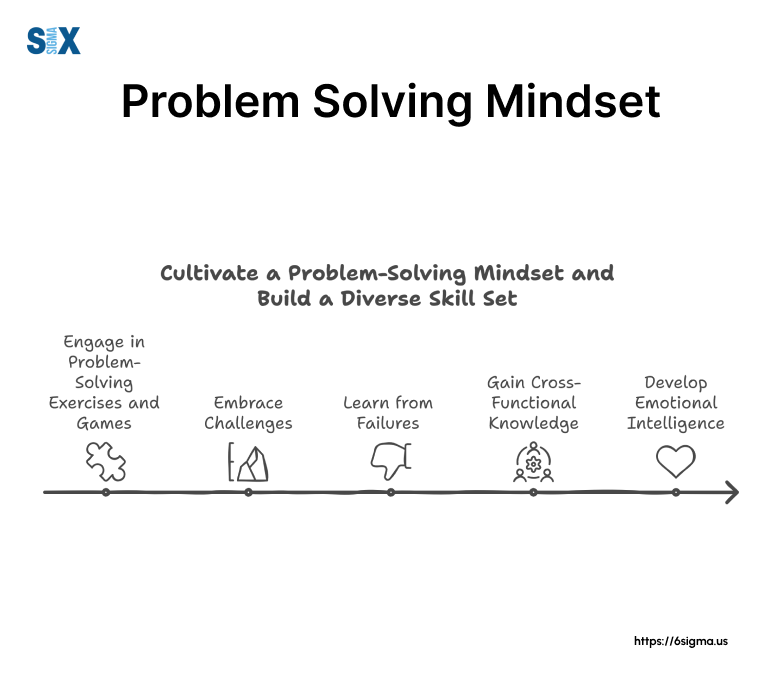
Continuous Learning and Practice
- Problem-Solving Exercises and Games
One of the most effective ways to enhance your problem-solving techniques is through regular practice. I often recommend brain teasers and logic puzzles to my workshop participants.
For instance, during a training session, we used the “Nine Dots Puzzle” to illustrate the importance of thinking outside the box. These exercises help sharpen your analytical skills and encourage creative thinking. - Application Opportunities
Nothing beats real-world experience when it comes to honing your problem-solving strategies. I always encourage my clients to seek out challenging projects within their organizations.
I mentored junior engineers by involving them in complex process improvement initiatives. This hands-on experience allowed them to apply various problem-solving techniques in a practical setting, accelerating their learning curve.
A proven way to refine your problem-solving skills is through a Six Sigma certification, which offers levels from Yellow Belt for beginners to Master Black Belt for experts.
Cultivating a Problem-Solving Mindset
- Embracing Challenges
The best problem solvers I’ve worked with, from startups to Fortune 500 companies, share one common trait: they view problems as opportunities rather than obstacles.
In a recent project with a healthcare provider, we reframed a patient care issue as a chance to innovate their service delivery model. This shift in perspective led to a breakthrough solution that improved patient satisfaction scores by 40%. - Learning from Failures
Failure is an inevitable part of the problem-solving process. What sets great problem solvers apart is their ability to learn from these setbacks.
I recall a project where our initial solution didn’t yield the expected results. Instead of getting discouraged, we conducted a thorough post-mortem analysis, which led to insights that ultimately drove the project’s success.
Building a Diverse Skill Set
- Cross-Functional Knowledge
The most effective problem solvers are those with a broad base of knowledge. Throughout my career, I’ve consistently encouraged professionals to step outside their comfort zones.
For example, I once advised a finance professional to shadow the manufacturing team. This cross-functional exposure enhanced her ability to solve interdepartmental issues, leading to more holistic solutions. - Emotional Intelligence
Technical skills are crucial, but emotional intelligence is equally important in problem-solving, especially in team settings.
During a workshop, we incorporated exercises to improve empathy and communication skills. This focus on emotional intelligence led to more collaborative problem-solving sessions and better team outcomes.
Challenge: Put Your Skills to the Test
I challenge you to take on a problem in your workplace using a technique you’ve never tried before. Perhaps use the “5 Whys” to dig into a recurring issue, or apply the SCAMPER method to innovate a product or process. Share your experience in the comments —I’d love to hear about your results!
Tips for Improving Problem-Solving Skills
- Practice regularly with puzzles and brain teasers
- Seek out challenging projects at work
- Reframe problems as opportunities for innovation
- Conduct post-mortem analyses on failed attempts
- Gain exposure to different departments and functions
- Develop emotional intelligence through targeted exercises
- Stay updated on industry trends and emerging technologies
- Participate in problem-solving workshops and seminars
- Mentor others to reinforce your skills
- Reflect on your problem-solving process and continuously refine it
Remember, becoming an expert problem solver is a journey, not a destination. As the business landscape evolves, so too must our problem-solving techniques.
By committing to continuous improvement and embracing new challenges, you’ll not only solve the problems of today but be prepared for the challenges of tomorrow.
Going Ahead
We’ve covered a wide range of problem-solving techniques, from the analytical rigor of Six Sigma to the creative approaches of design thinking.
We’ve explored how these methods can be applied across various industries and adapted for remote environments. We’ve also looked at emerging trends, showing how AI and big data are reshaping the landscape of problem-solving.
Key takeaways:
- The importance of a structured problem-solving process
- The power of combining analytical and creative techniques
- The value of team-based approaches in complex problem-solving
- The potential of data-driven and AI-enhanced problem-solving methods
- The necessity of continuously developing your problem-solving skills
Remember, the most effective problem solvers are those who can adapt their approach to the unique challenges they face. Whether you’re troubleshooting a manufacturing issue, optimizing a business process, or tackling a global supply chain challenge, the techniques we’ve discussed provide a robust toolkit for success.
As you move forward in your career, I encourage you to implement these problem-solving techniques in your daily work. Start with small challenges and gradually apply these methods to more complex problems. Share your learnings with your team and create a culture of continuous improvement in your organization.
The ability to solve problems effectively is more than just a skill—it’s a competitive advantage in today’s rapidly changing business landscape. By honing your problem-solving abilities, you’re not just preparing for the challenges of today, but positioning yourself as a leader for the challenges of tomorrow.
Remember, every problem is an opportunity in disguise. Happy problem-solving!
SixSigma.us offers both Live Virtual classes as well as Online Self-Paced training. Most option includes access to the same great Master Black Belt instructors that teach our World Class in-person sessions. Sign-up today!
Virtual Classroom Training Programs Self-Paced Online Training Programs







